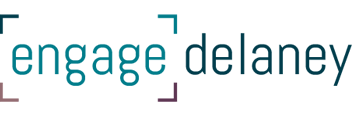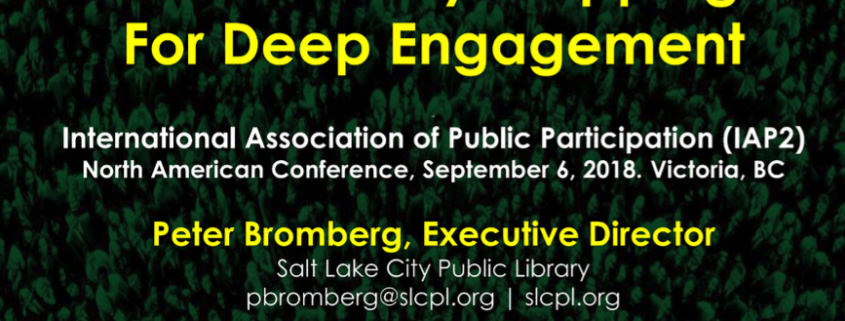Directed Storytelling + Journey Mapping for Deep Engagement (and better service design)
A key question in my practice is this: “how do I continue to bring a creative approach to engaging and understanding the needs of the populations I seek to engage?”. Events such as the iap2 North American Conference often provide me with the welcome opportunity to take a fresh look at this very question.
I absolutely love a good story. So I was delighted to attend Peter Bromberg and Stacee Adams’ presentation on directed storytelling and journey mapping. Bromberg and Adams walked us through how these techniques were successfully applied to improve the design of services at the Salt Lake City Library, where Bromberg works as the Executive Director.
Service design is the application of design methods to define, create, and iterate service experiences. If you’ve ever waited to renew your driver’s license you’ll know what I mean by service experiences. In the world of service design, a designer would use the following techniques to understand how that experience makes you do, think, and feel. This new understanding is then applied to enhance the service experience that is on offer.
The key stages of service design look like the following (and our workshop focussed on Stage 1):
- Sense-making + exploration (creating understanding through collecting data)
- Tools:
- Directed Storytelling (interview-based questions where you ask a stakeholder to tell you about their relationship to a certain entity/process/service)
- Empathy Map (similar to a ‘user persona’ that can represent a group of stakeholders’ needs)
- Ecosystem Mapping (your stakeholders’ life)
- Journey Mapping (about a specific experience, e.g. renewing your drivers’ license)
- Interview Intercepts (e.g. speaking with people after a process is complete, or a person has used a service to determine the quality of their experience and identify opportunities for improvement)
- Service Safari (using ethnographic techniques to observe people’s behaviour in service environments where there is an experience that is facilitated by other people, e.g. checking into a hotel)
- Tools:
- Ideas and Concepts (divergent thinking – brainstorming + ideating)
- Vision and Intent (Convergent Thinking – Narrow your ideas and try something)
- Implementation and Measurement
If this is seeming complicated, Bromberg and Adams bottom lined it like this: the goal is to understand people, the strategy is to talk with them, and the methods they used to accomplish this were directed storytelling, ecosystem and journey mapping. In small groups we began to interview each other and our relationship to iap2: how we engaged, what obstacles we faced, and where we would like to go. We were then asked to journey map our experience on our last night out (a specific experience), moment by moment, which included questions about what we were doing, thinking and feeling at each stage of the evening (experience). After each step was laid out, we were asked to rate how we felt at that point in time, on a scale of happy, to neutral, to unhappy. A linear graph was then created from each of these points that clearly displayed our emotional journey during the experience.
After completing both exercises, we were able to reflect on what we found surprising, what the needs of the person were, and what obstacles existed. From this perspective, it was easy to see how to help this person on their journey. It was also easy to see how applying these techniques could help me design a better process for a client and their stakeholders, and apply some of these tools to help clients better engage on the complex issues they are grappling with.
I left feeling energized and inspired to adapt these techniques to the next project that could use them.
The definite mark of a wonderful session.



